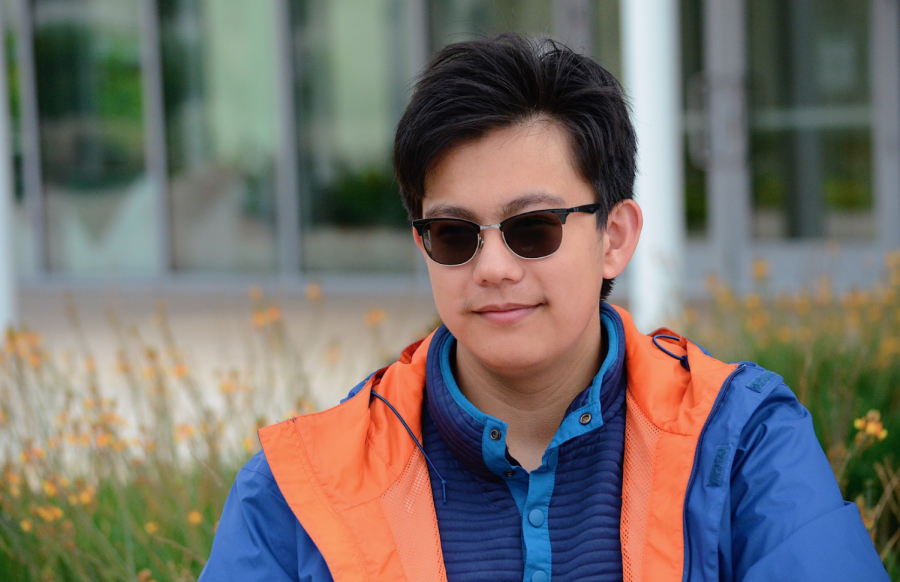Humans of Harker: The art of communication
Raymond Banke expresses his opinion through his passions
“As an artist, it’s so important that I tell myself, ‘believe in what you make.’ I do have art pieces that reflect ideas and are a little controversial that I may not entirely agree with,” Raymond Banke (12) said. “I feel like if I don’t believe in some way in what I’m creating, it’s just so much harder to come across as someone who genuinely values what they’re doing. Not only do people respect me more, but I appreciate myself more.”
A small fish dotted with gold and white specks darts across the aquarium, eagerly awaiting its meal. A hand slowly submerges itself into the water from above, offering multicolored flakes of fish food to the flat, almost pancake like sea creature. Raymond Banke (12) calmly removes his hand as to not startle the fish, then lets his eyes follow the fish’s movements, observing the animal’s interaction with the tank to gain a sense of what his aquascape project should look like.
To most, the arts and sciences are diametrically opposed subjects, but to Raymond, the fusion of the two separate studies simply highlight his love of interaction with others.
“One of the things I really like about art and biology is that even if you’re not necessarily an expert in one of those fields, I think everyone is able to discern what is good to art and appreciate life,” Raymond said, tugging on the sleeves of his light blue sweatshirt that he had tied around his shoulders. “I think everyone is excited [about art], even if they’re not super into the nitty-gritty aspect of looking at fish, everyone knows what good design is. That’s what I really love. That universal connection of art and aquatic biology.”
Raymond began keeping fish in the first grade, then received his first saltwater aquarium in fifth grade. From there, he began exploring the importance of biology more intensely.
“I think biology is really important because it’s not only a way of communicating the issues in our environment, but it’s also a way of fascinating someone with something tangible.” Raymond said. “There are so many tangible environmental impacts which can all be done in something pretty, like a box you can put in your house. I love that sense of portability, like having a little slice of the ocean with you.”
Within all of his activities, Raymond is unafraid to take risks, which carries over to other various parts of his life. He does not hesitate to participate in activities that appeal to him, and his outgoing personality and reflective demeanor mark him as an engaging conversationalist and friend.
“I understand a lot more of the substance behind him. He’s not just someone who says whatever’s on his mind, but he also thinks really hard about the things he says. And he’s not afraid to pursue what he wants to do and what he’s interested in, which is what I think makes him so interesting,” Cindy Wang (12), a friend of Raymond’s since elementary school, said.
However, Raymond wasn’t always so open about communicating his thoughts to others. Throughout high school, he has improved on himself and now engages in thoughtful exchanges with his peers. During this journey, he has also begun to express himself more freely through his art.
“To me, art is the most important since it’s a very timeless communication form, especially for people who don’t have a voice. I love how art is functional, quiet. It does what it is supposed to do. However, at the same time, art can be a form of social protest,” Raymond said. “Art’s such a visual form of communication. For people who don’t necessarily want to argue about something, art can be a great way of presenting something that provokes emotions.”
Raymond fully began exploring the world of art when he entered Harker in 9th grade. Along the way, he received guidance from his art teacher and mentor, Pilar Aguero-Esparza. In the fall, Raymond fused elements of marine biology and design to create a detailed aquascape exhibit.
“He’s become more fearless, especially this year. His project in the fall involved a fish tank with live fish. It’s really fun, as a teacher, to be able to see someone grow from freshman year to senior year and really evolve in his thinking.” Pilar Aguero-Esparza said. “It was very exciting to see a young artist come into his own in terms of his work. Watching him work on that project was really terrific.”
In addition to his love for art and biology, Raymond finds joy in conversations with his peers. He particularly likes to debate diverse topics with his friend Cameron Jones (12), who he met in his freshman Study of Visual Arts class.
“We’ve had a lot of great discussions. We actually talked about politics a lot. That’s something we like to discuss, and I feel we’ve grown through these discussions,” said Cameron. “They’ve made us into different and better people: being able to see two sides to an argument and agree to disagree on an issue. His views don’t necessarily align with mine, but we always enjoy the discussion.”
As he continues with his journey, Raymond hopes to create more art pieces that reflect his ideals.
“As an artist, it’s so important that I tell myself, ‘believe in what you make.’ I do have art pieces that reflect ideas and are a little controversial that I may not entirely agree with,” Raymond said. “I feel like if I don’t believe in some way in what I’m creating, it’s just so much harder to come across as someone who genuinely values what they’re doing. Not only do people respect me more, but I appreciate myself more.”

Esha Gohil (12) is the co-editor-in-chief of Humans of Harker and the photo editor of Harker Aquila. This is her fourth year on staff, and this year she...

Muthu Panchanatham (12) is the opinion editor of Harker Aquila and The Winged Post, and this is his fourth year on staff. This year, he is excited to cover...


















![“[Building nerf blasters] became this outlet of creativity for me that hasn't been matched by anything else. The process [of] making a build complete to your desire is such a painstakingly difficult process, but I've had to learn from [the skills needed from] soldering to proper painting. There's so many different options for everything, if you think about it, it exists. The best part is [that] if it doesn't exist, you can build it yourself," Ishaan Parate said.](https://harkeraquila.com/wp-content/uploads/2022/08/DSC_8149-900x604.jpg)




![“When I came into high school, I was ready to be a follower. But DECA was a game changer for me. It helped me overcome my fear of public speaking, and it's played such a major role in who I've become today. To be able to successfully lead a chapter of 150 students, an officer team and be one of the upperclassmen I once really admired is something I'm [really] proud of,” Anvitha Tummala ('21) said.](https://harkeraquila.com/wp-content/uploads/2021/07/Screen-Shot-2021-07-25-at-9.50.05-AM-900x594.png)







![“I think getting up in the morning and having a sense of purpose [is exciting]. I think without a certain amount of drive, life is kind of obsolete and mundane, and I think having that every single day is what makes each day unique and kind of makes life exciting,” Neymika Jain (12) said.](https://harkeraquila.com/wp-content/uploads/2017/06/Screen-Shot-2017-06-03-at-4.54.16-PM.png)








![“My slogan is ‘slow feet, don’t eat, and I’m hungry.’ You need to run fast to get where you are–you aren't going to get those championships if you aren't fast,” Angel Cervantes (12) said. “I want to do well in school on my tests and in track and win championships for my team. I live by that, [and] I can do that anywhere: in the classroom or on the field.”](https://harkeraquila.com/wp-content/uploads/2018/06/DSC5146-900x601.jpg)
![“[Volleyball has] taught me how to fall correctly, and another thing it taught is that you don’t have to be the best at something to be good at it. If you just hit the ball in a smart way, then it still scores points and you’re good at it. You could be a background player and still make a much bigger impact on the team than you would think,” Anya Gert (’20) said.](https://harkeraquila.com/wp-content/uploads/2020/06/AnnaGert_JinTuan_HoHPhotoEdited-600x900.jpeg)

![“I'm not nearly there yet, but [my confidence has] definitely been getting better since I was pretty shy and timid coming into Harker my freshman year. I know that there's a lot of people that are really confident in what they do, and I really admire them. Everyone's so driven and that has really pushed me to kind of try to find my own place in high school and be more confident,” Alyssa Huang (’20) said.](https://harkeraquila.com/wp-content/uploads/2020/06/AlyssaHuang_EmilyChen_HoHPhoto-900x749.jpeg)



